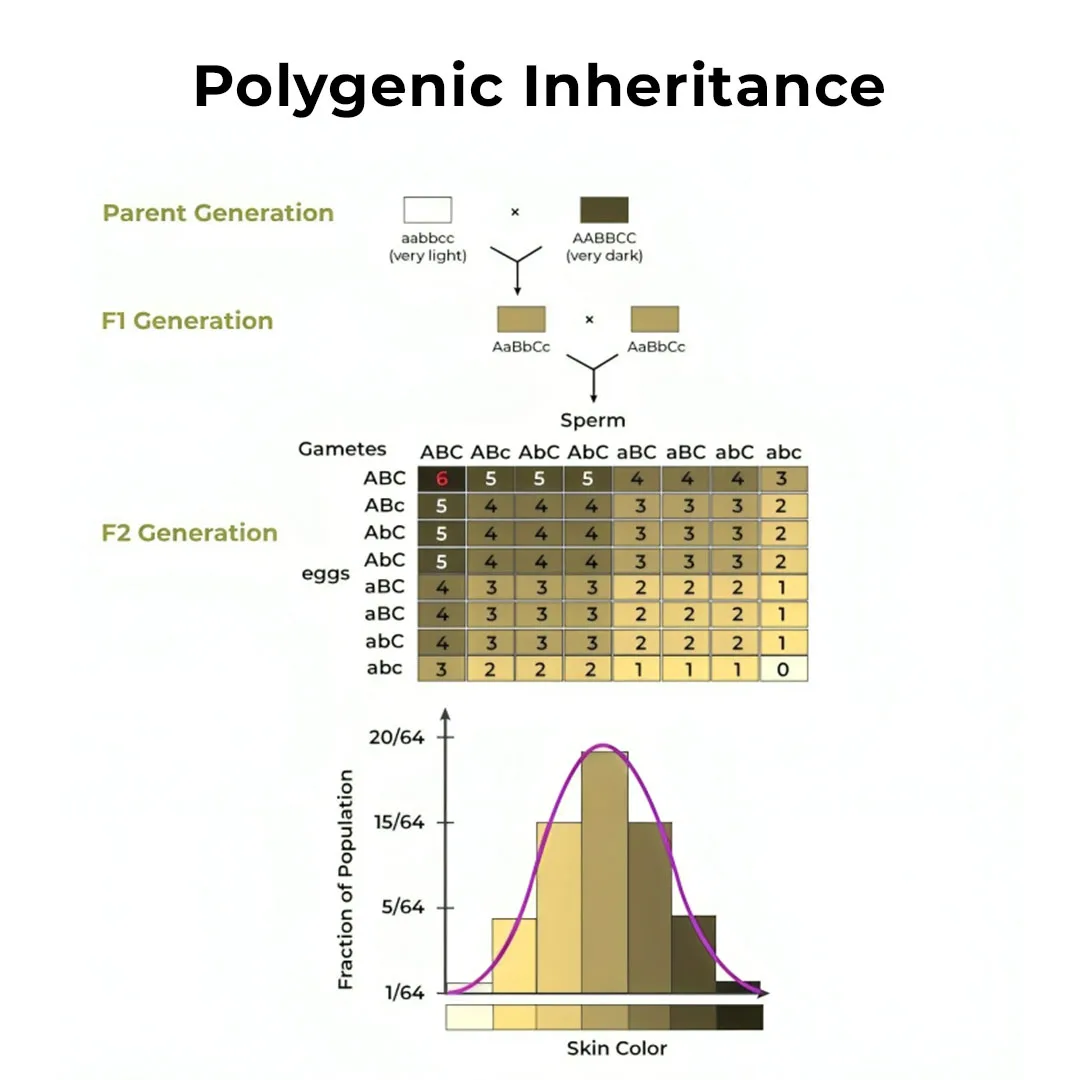
Polygenic Inheritance: Inheritance is the biological process through which offspring acquire specific traits from their parents. Characteristics like height, skin pigmentation, eye color, and hair color are examples of polygenic inheritance, where the interaction of multiple genes determines these traits. These genes, known as alleles, are inherited from parents and can have an additive or similar effect on a single trait.
Polygenic inheritance is so named because it involves the inheritance of multiple genetic combinations from parents. In simpler terms, there is no fixed height for being tall or short, indicating the presence of several genetic combinations. This concept is an important topic covered in the chapter "Principles of Inheritance and Variation" and is relevant for NEET aspirants. Detailed notes on polygenic inheritance are provided below for further study.Sexual Reproduction in Flowering Plants
Polygenic Inheritance
Polygenic inheritance, derived from "poly-" (many) and "-genic" (gene), refers to the genetic inheritance patterns controlled by multiple genes rather than a single gene. This complexity results in a wider range of trait variations. Eye color is a good example, as it is thought to be influenced by up to fifteen genes. Polygenic inheritance differs from Mendelian inheritance in terms of pattern and expression. Mendelian Inheritance involves monogenic traits, where the expression is either dominant or recessive. In contrast, polygenic inheritance does not exhibit complete dominance. Instead, the phenotypic expression in offspring is a blend or addition of parental traits. This additive effect characterizes polygenic inheritance.
Polygenic Inheritance Characteristics
Polygenic inheritance refers to the inheritance pattern where multiple genes collectively influence the expression of a single trait. Rather than being governed by a single gene, the phenotype of the trait results from the combined effects of several genes. Polygenic inheritance has several key features, including:- Involvement of multiple genes: Numerous genes contribute to the expression of the trait. Each gene's impact is generally minor, but together, they determine the final phenotype.
- Additive effects: Alleles of each gene tend to have an additive effect on the phenotype. This means that the effects of alleles from both parents are cumulatively considered. For instance, if a gene has alleles for tallness and shortness, an individual inheriting two tallness alleles will be taller than someone with one tallness and one shortness allele.
- Continuous variation: Polygenic traits exhibit a continuum of phenotypic variation due to the additive effects of multiple genes. This results in a range of possible phenotypes, rather than distinct categories. For example, human height varies from very short to very tall.
- Environmental influence: Apart from genetic factors, environmental conditions can also influence polygenic traits. For instance, nutrition can impact height, while sun exposure can affect skin colour.
How Do Polygenic Diseases Occur?
Polygenic diseases occur due to the combined effects of multiple genes, each contributing a small amount to the overall risk of developing the disease. Unlike single-gene disorders, where mutations in a single gene cause the disease, polygenic diseases result from the complex interaction of many genes, along with environmental factors. In polygenic diseases, each gene involved may have a small effect on its own. Still, when combined with the effects of other genes and environmental factors, the risk of developing the disease increases. These diseases often show a continuous range of symptoms and severity, making them challenging to predict and diagnose.| Other NEET Biology Topics | ||
|---|---|---|
| Ribosomes | Pollination | Apomixis |
| Centrosome | Embryo | Tissues |
| Rhizopus | Pinus | Gluconeogenesis |
| Chlamydomonas | Chara | Ribs |
Polygenic Inheritance Examples
Polygenic inheritance refers to the mechanism by which the interaction of multiple genes controls a trait, each exerting a small, additive effect on the phenotype. This mode of inheritance typically results in a continuous range of phenotypic variations rather than distinct categories. Several examples illustrate this concept:- Human Skin Colour: The wide range of human skin tones is a manifestation of polygenic inheritance. Multiple genes influence the production of melanin, the pigment responsible for skin colour, leading to the diversity of skin tones observed in human populations.
- Height: Polygenic inheritance also plays a role in determining an individual's height. Multiple genes contribute to the development of skeletal structures and growth patterns, resulting in the variation in height seen among individuals.
- Eye Colour: The colour of human eyes is determined by the interaction of several genes. The combination of these genes contributes to the diverse spectrum of eye colours observed in different individuals.
- Hair Colour: Similarly, the colour of human hair is influenced by multiple genes. The interaction of these genes determines the specific shade of hair colour exhibited by an individual.
- Susceptibility to Disease: Certain diseases, such as heart disease and diabetes, are influenced by polygenic factors. Multiple genes, in conjunction with environmental factors, contribute to an individual's predisposition to these diseases.
Polygenic Inheritance in Humans
Polygenic inheritance in humans involves the transmission of traits controlled by multiple genes, each contributing to the phenotype to varying degrees. Unlike single gene traits that follow Mendelian patterns, polygenic traits in humans often exhibit continuous variation, such as height, skin colour, or intelligence. In polygenic inheritance, each gene involved may have different alleles, and the combination of these alleles from both parents determines the offspring's phenotype. The interaction of multiple genes can lead to a wide range of phenotypes, often resulting in a bell-shaped curve of distribution in a population.- Height: Human height is influenced by multiple genes, with each gene contributing to a small portion of the overall height variation.
- Skin Colour: The variation in human skin colour is controlled by multiple genes affecting the production of melanin, the pigment responsible for skin colour.
- Intelligence: Intelligence is a complex trait influenced by multiple genes, with each gene contributing to different aspects of cognitive function.
- Body Mass Index (BMI): BMI, a measure of body fat based on height and weight, is influenced by multiple genes controlling factors such as metabolism and appetite.
Polygenic Inheritance in Plants
Polygenic inheritance in plants involves the transmission of traits controlled by multiple genes, each contributing to the phenotype to varying degrees. Unlike single gene traits that follow Mendelian patterns, polygenic traits often exhibit continuous variation, such as plant height, weight, or grain yield. In polygenic inheritance, each gene involved may have different alleles, and the combination of these alleles from both parents determines the offspring's phenotype. The interaction of multiple genes can lead to a wide range of phenotypes, often resulting in a bell-shaped curve of distribution in a population. Examples of polygenic traits in plants include:- Grain Yield: Multiple genes control traits such as tiller number, grain size, and plant height, influencing the yield of grains in crops like wheat, rice, or maize.
- Plant Height: The height of a plant can be influenced by multiple genes, with each gene contributing to a small portion of the overall height variation.
- Fruit Size: The size of fruits, such as in tomatoes or watermelons, is controlled by multiple genes affecting factors like cell division, expansion, and sugar content.
- Leaf Size: The size of leaves in plants can be influenced by the interaction of multiple genes affecting cell growth and division.
- Kernel Colour of Wheat: Wheat kernel colour is determined by three independently assorted pairs of alleles. Dark red wheat kernels result from the dominant allele AABBCC, while white kernels result from the recessive allele aabbcc. Crossing AABBCC wheat with aabbcc produces an F1 generation with red kernels intermediate to AaBbCc. In the F2 generation, one white kernel plant is produced for every 63 red kernel plants of various shades.
- Corolla Length in Tobacco: The length of the tobacco plant's corolla is determined by five genes, leading to variation in corolla length due to polygenic inheritance.
Mendelian Inheritance vs. Polygenic Inheritance
Gregor Mendel, a monk, conducted pioneering studies on the inheritance patterns of the pea plant, Pisum sativum, from 1858 to 1863. His work laid the foundation for Mendelian inheritance, which focuses on phenotypes controlled by a single gene pair. In this model, traits are typically either dominant or recessive. For example, in the garden pea, flower color is determined by one gene with two alleles: purple (dominant, noted as B) and white (recessive, noted as b). A Punnett square can be used to predict the outcomes of crosses between parents with different allele combinations. This type of inheritance often results in distinct phenotypic groups, known as discontinuous variation. In contrast, polygenic inheritance involves multiple genes and leads to continuous variation in traits. The following table provides a comparison of Mendelian Inheritance and Polygenic Inheritance:| Mendelian Inheritance vs. Polygenic Inheritance | ||
|---|---|---|
| Aspect | Mendelian Inheritance | Polygenic Inheritance |
| Number of Genes | Involves a single gene. | Involves multiple genes. |
| Allele Interaction | Dominant-recessive interactions. | Cumulative and additive effects of alleles. |
| Phenotypic Variation | Discrete, distinct phenotypes. | Continuous variation, often forming a bell curve. |
| Inheritance Patterns | Follows specific patterns (e.g., dominant). | Patterns not as easily predicted (e.g., height). |
| Environmental Influence | Limited influence. | Significant influence, affecting trait expression. |
| Examples | Seed colour in peas, blood type. | Height, skin colour, intelligence. |
| NEET Exam Important Links | |
|---|---|
| NEET Biology Syllabus | NEET Biology Diagrams |
| NEET Biology MCQ | NEET Biology Chapter wise Weightage |
| NEET Biology Notes | NEET Previous Year Question papers |
Polygenic Inheritance FAQs
What is an example of polygenic inheritance in humans?
Many human traits, such as skin and hair colour, height, eye colour, disease susceptibility, intelligence, blood pressure, bipolar disorder, autism, and longevity, exhibit polygenic inheritance.
What are some polygenic diseases in humans?
Polygenic diseases in humans are conditions that require the involvement of multiple genetic factors for manifestation. Disorders like heart disease and diabetes are believed to be polygenic, where several genes interact to influence the development of the disease.
Who discovered polygenic inheritance?
The theory of polygenic inheritance, which suggests that traits result from the combined effects of multiple genes, was developed by Nils Herman Nilsson-Ehle and Edward Murray East. Nilsson-Ehle advanced the "multiple factor" theory, proposing that traits are influenced by more than one gene.
Is diabetes a polygenic disease?
Yes, the most common forms of diabetes, type 1 and type 2, are polygenic disorders. They result from changes or defects in multiple genes, along with environmental factors such as obesity in the case of type 2 diabetes.
Is human height determined by dominant or recessive genes?
Human height is a polygenic trait, meaning it is influenced by multiple genes. Environmental factors also play a significant role, making it inappropriate to categorise it as solely dominant or recessive.
Talk to a counsellorHave doubts? Our support team will be happy to assist you!

Check out these Related Articles
Free Learning Resources
PW Books
Notes (Class 10-12)
PW Study Materials
Notes (Class 6-9)
Ncert Solutions
Govt Exams
Class 6th to 12th Online Courses
Govt Job Exams Courses
UPSC Coaching
Defence Exam Coaching
Gate Exam Coaching
Other Exams
Know about Physics Wallah
Physics Wallah is an Indian edtech platform that provides accessible & comprehensive learning experiences to students from Class 6th to postgraduate level. We also provide extensive NCERT solutions, sample paper, NEET, JEE Mains, BITSAT previous year papers & more such resources to students. Physics Wallah also caters to over 3.5 million registered students and over 78 lakh+ Youtube subscribers with 4.8 rating on its app.
We Stand Out because
We provide students with intensive courses with India’s qualified & experienced faculties & mentors. PW strives to make the learning experience comprehensive and accessible for students of all sections of society. We believe in empowering every single student who couldn't dream of a good career in engineering and medical field earlier.
Our Key Focus Areas
Physics Wallah's main focus is to make the learning experience as economical as possible for all students. With our affordable courses like Lakshya, Udaan and Arjuna and many others, we have been able to provide a platform for lakhs of aspirants. From providing Chemistry, Maths, Physics formula to giving e-books of eminent authors like RD Sharma, RS Aggarwal and Lakhmir Singh, PW focuses on every single student's need for preparation.
What Makes Us Different
Physics Wallah strives to develop a comprehensive pedagogical structure for students, where they get a state-of-the-art learning experience with study material and resources. Apart from catering students preparing for JEE Mains and NEET, PW also provides study material for each state board like Uttar Pradesh, Bihar, and others
Copyright © 2025 Physicswallah Limited All rights reserved.
Get App









